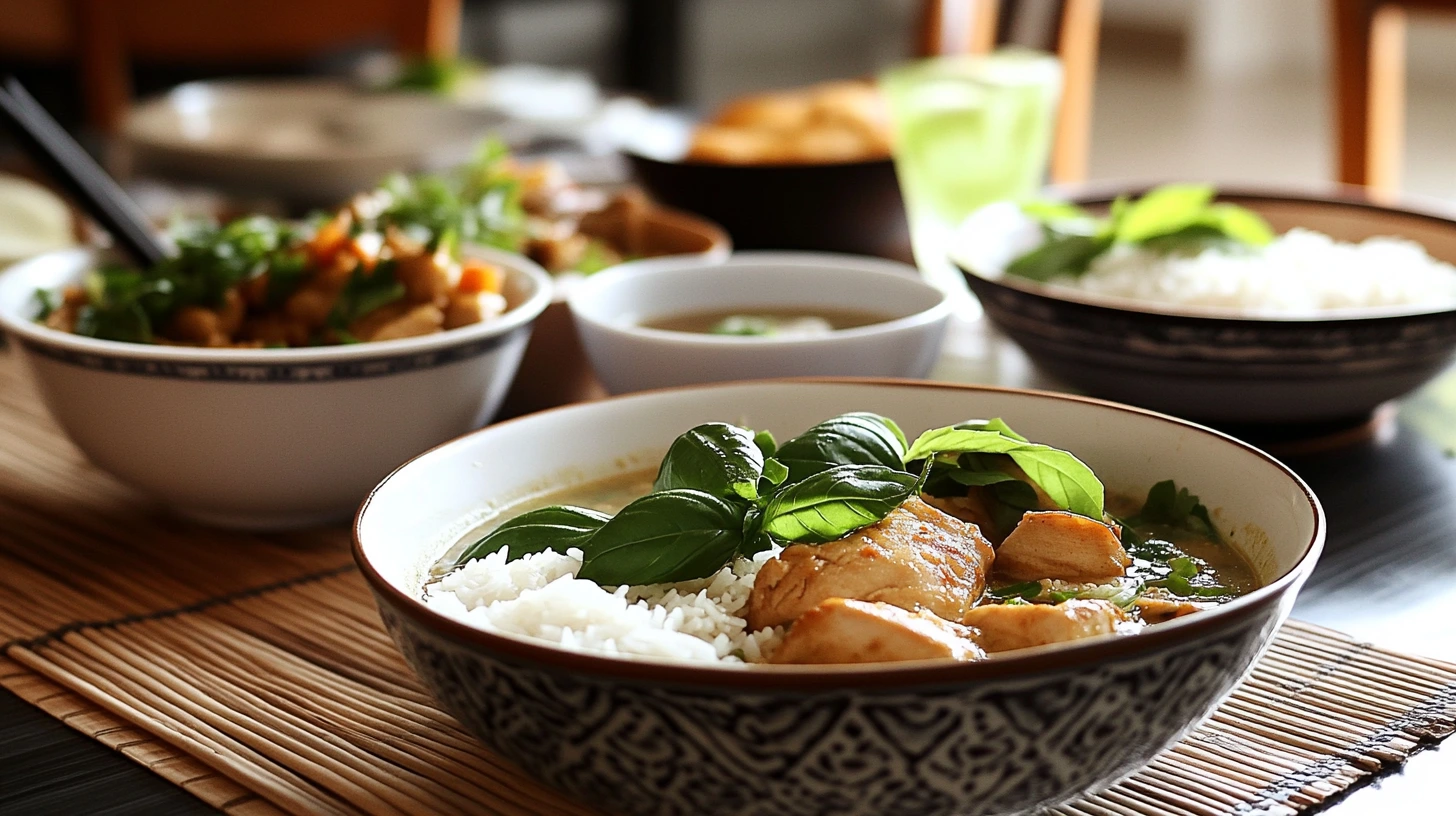Asian Food Recipes cuisine is one of the most diverse, flavorful, and exciting food cultures in the world. With dishes that range from spicy curries and rich noodle soups to delicate sushi rolls and comforting rice bowls, there’s truly something for every palate. Whether you’re craving the bold spices of South Asia, the umami depth of East Asian broths, or the vibrant freshness of Southeast Asian herbs, the recipes of this continent are as vast as its landscapes.
The beauty of Asian food recipes lies in their balance—sweet and salty, spicy and sour, crunchy and soft. Many dishes are designed not only to nourish but also to provide harmony and joy in every bite. From street vendors in Bangkok to home kitchens in Mumbai and high-end restaurants in Tokyo, Asian cooking traditions continue to influence and inspire chefs and food lovers globally.
In this article, we’ll take a flavorful journey across Asia and introduce 15 irresistible Asian food recipes you can try at home. You’ll find everything from quick stir-fries to slow-simmered curries, complete with ingredients, techniques, and cultural insights that bring these dishes to life. Ready your wok or steamer—we’re diving into the vibrant world of Asian food recipes!
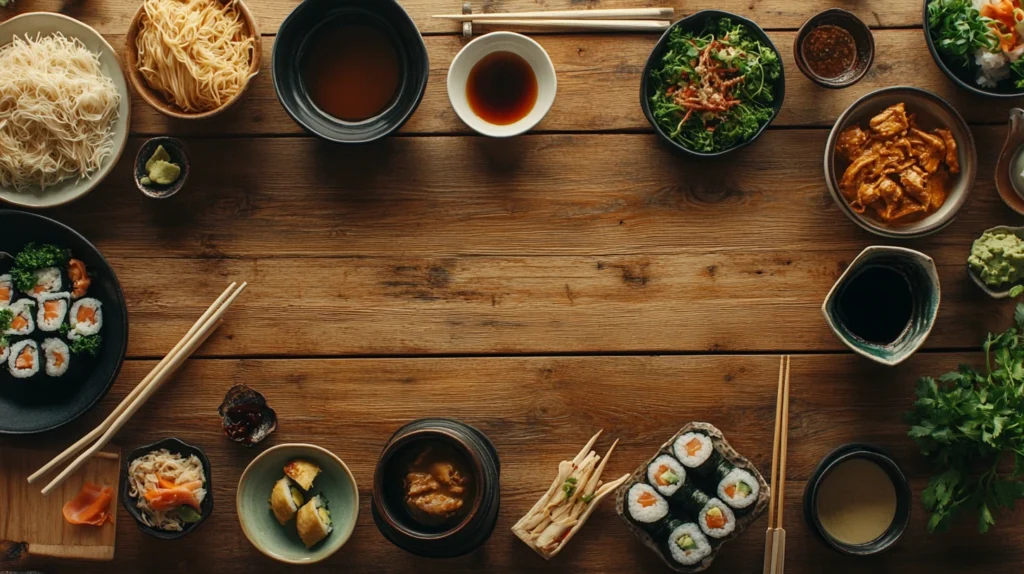
The Allure of Asian Cuisine
Why Asian Food Recipes Are Loved Worldwide
Asian cuisine has a long-standing reputation for being both delicious and versatile. One major reason for its global popularity is the rich variety of flavors that can be found in its dishes. A single Asian recipe often brings together ingredients that appeal to every part of the taste spectrum—sweet, salty, sour, spicy, and umami.
Asian food recipes are also incredibly adaptable. Whether you’re vegetarian, vegan, gluten-free, or a meat-lover, you’ll find an Asian dish that suits your lifestyle. Many dishes are naturally plant-based or can be easily modified, making them accessible to a wide audience.
Another reason for the worldwide appeal is the simplicity of many traditional dishes. You don’t need to be a trained chef to whip up a great pad thai or miso soup. With a few pantry staples and some fresh ingredients, you can create meals that are both comforting and exotic.
Finally, the visual presentation of Asian food can’t be overlooked. From neatly arranged sushi rolls to colorful bowls of bibimbap, aesthetics play a major role in many Asian food traditions, making the experience enjoyable for all senses.
Why do people across the globe fall in love with dishes from Asia? It might be the complexity of flavors, the cultural heritage, or simply the comfort they bring. Much like this Shakshuka With Sourdough Breakfast recipe that brings a hearty blend of tradition and taste to the table, Asian meals often balance nutrition with satisfying depth.
The Health Benefits of Asian Dishes
Many Asian food recipes emphasize fresh vegetables, lean proteins, and healing herbs and spices, which naturally lead to healthier meals. Ingredients like ginger, garlic, turmeric, and green tea have long been celebrated for their health-boosting properties.
For example, traditional Japanese meals often center around grilled fish, fermented vegetables, and miso, all of which support digestive and immune health. In Thai and Vietnamese cuisine, the generous use of herbs such as basil, mint, and cilantro not only enhances flavor but also contributes antioxidant benefits.
Asian cuisines often avoid heavy dairy or processed ingredients, favoring light sauces and broths instead of cream-based or buttery options. This helps keep dishes lower in saturated fats without compromising taste. Portion control is another embedded principle—many meals are served family-style with smaller, varied dishes that promote mindful eating.
In short, Asian food recipes don’t just taste amazing—they often come with the added bonus of nourishing your body, boosting immunity, and even supporting long-term health goals like weight management or reduced inflammation.
Popular East Asian Food Recipes You Can Make at Home

East Asian cuisine is a pillar of global gastronomy, known for its delicate balance of flavor, presentation, and nutrition. Countries like China, Japan, and Korea have shared their rich culinary heritage with the world through dishes that have become staples in homes and restaurants alike. Whether you’re craving something savory, umami-packed, or slightly sweet, East Asian recipes offer endless possibilities.
Easy Chinese Stir-Fry – A Quick Asian Food Recipe Favorite
Chicken stir-fry is a go-to recipe in many Chinese households—and for good reason. It’s quick, flexible, and brimming with flavor. This dish typically features tender chicken pieces sautéed with colorful vegetables like bell peppers, broccoli, and carrots, all tossed in a savory sauce made from soy sauce, garlic, ginger, and a touch of sesame oil.
Cooking Tips for Chinese Stir-Fry
- High Heat is Key: Always cook in a wok or wide skillet over high heat to keep ingredients crisp and evenly cooked.
- Prep First, Cook Fast: Stir-frying is quick, so have all your ingredients chopped and sauces mixed before you start.
- Thicken the Sauce: A cornstarch slurry (cornstarch + water) gives that signature glossy, restaurant-style finish.
Pair it with steamed jasmine rice or noodles, and you’ve got a meal in under 30 minutes that’s better than takeout.
Authentic Japanese Sushi Rolls
Sushi is arguably Japan’s most iconic dish and has gained massive global popularity for its elegance and taste. Making sushi rolls at home may sound intimidating, but with the right ingredients and a little practice, it’s both fun and rewarding.
Sushi is an art form.It’s elegant, delightful, and rich in cultural essence—just like the stunning allure of this Purple Velvet Cake. Whether you’re using fish or sticking with vegetarian fillings, sushi offers a calm, creative cooking experience.
Sushi Ingredients You’ll Need
- Sushi Rice: Seasoned with rice vinegar, sugar, and salt for the perfect balance.
- Nori Sheets: Dried seaweed to hold the rolls.
- Fillings: Fresh fish like tuna or salmon, avocado, cucumber, or imitation crab.
- Rolling Tools: A bamboo mat helps form tight, even rolls.
The most common rolls include California Roll, Spicy Tuna Roll, and Vegetable Maki. Serve with soy sauce, wasabi, and pickled ginger for the full sushi experience. While raw fish is traditional, many beginners start with cooked or vegetarian versions for convenience.
Korean Bibimbap
Bibimbap, meaning “mixed rice,” is a vibrant Korean dish that combines warm rice with sautéed vegetables, seasoned meat (often beef), a fried egg, and gochujang (Korean chili paste). It’s not just a meal—it’s a colorful bowl of nutrition and flavor.
How to Build the Perfect Bibimbap Bowl
- Base: Steamed white or brown rice.
- Toppings: Sautéed spinach, bean sprouts, mushrooms, zucchini, and carrots.
- Protein: Marinated beef bulgogi or tofu.
- A sunny-side-up egg brings a touch of richness and enhances the dish’s visual appeal.
- Sauce: A generous spoonful of gochujang for heat and umami.
Mix everything together before eating to enjoy the harmony of textures and flavors. Some versions even use a hot stone bowl (dolsot), which crisps up the rice at the bottom—a real treat.
These three East Asian recipes represent just a taste of the variety and culinary artistry found in this region. Each one offers a unique experience, from the simplicity of stir-fry to the technique of sushi rolling and the colorful satisfaction of bibimbap.
Must-Try Southeast Asian Food Recipes for Every Home Cook
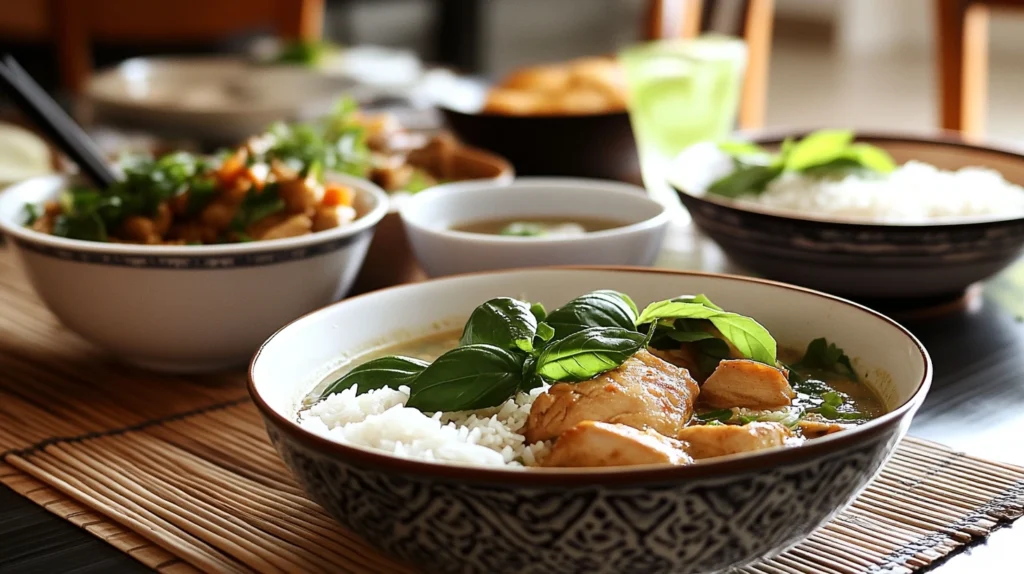
Southeast Asia offers an explosion of flavors in every dish. With influences from ancient trade routes, local farming traditions, and cultural diversity, this region brings together sweet, salty, sour, and spicy in unique harmony. Ingredients like lemongrass, galangal, coconut milk, fish sauce, and fresh herbs are staples in these cuisines, making them distinct and unforgettable.
Thai Green Curry
Thai green curry is a creamy, spicy, and herbaceous dish that warms the soul. Unlike red curry, green curry uses green chilies, giving it a vibrant color and a punchy heat balanced by the richness of coconut milk.
Key Ingredients for Thai Green Curry
- Green Curry Paste: Traditionally made with green chilies, garlic, lemongrass, galangal, and kaffir lime peel.
- Coconut Milk: The creamy base that softens the spice and adds sweetness.
- Protein: Chicken, shrimp, or tofu are popular choices.
- Vegetables: Eggplant, bamboo shoots, and bell peppers.
- Herbs: Thai basil and cilantro for finishing.
Pair Thai green curry with fragrant jasmine rice or tender rice noodles for a satisfying meal. Adjust the heat by controlling how much curry paste you add. Store-bought pastes are available, but homemade paste always delivers a fresher, deeper flavor.
Vietnamese Pho – A Classic Asian Cuisine Recipe
Pho is Vietnam’s signature dish—a nourishing noodle soup typically made with beef broth, rice noodles, and thinly sliced meat, served with an array of fresh herbs and condiments.
Elements of an Authentic Pho
- Broth: Simmered for hours with beef bones, star anise, cinnamon, cloves, and charred onion and ginger.
- Noodles: Flat rice noodles (bánh phở).
- Meat: Sliced rare beef, brisket, or meatballs.
- Toppings include fresh bean sprouts, Thai basil, lime wedges, sliced chilies, and a splash of hoisin or sriracha.
Making pho from scratch is a labor of love, but you can also make quicker versions using pressure cookers or premade broth bases. Either way, the aromatic comfort of pho makes it a favorite all over the world.
Filipino Chicken Adobo
Often regarded as the unofficial national dish of the Philippines, adobo holds that title for good reason.It’s savory, tangy, slightly sweet, and absolutely comforting. The dish involves marinating and simmering chicken (or pork) in a mixture of soy sauce, vinegar, garlic, bay leaves, and peppercorns.
The balance of salty, sweet, and tangy in adobo is a flavor bomb—kind of like biting into the perfect dessert, such as this Easter Chocolate Lasagna but in savory form. It’s an easy crowd-pleaser and a great introduction to Filipino cooking.
Cooking Filipino Adobo at Home
- Marinate the Chicken: Combine soy sauce, vinegar, crushed garlic, bay leaves, and whole black peppercorns.
- Simmer Slowly: Let the chicken cook low and slow in its marinade until tender.
- Reduce the Sauce: After the meat is cooked, reduce the sauce until it thickens slightly and coats the chicken.
Adobo is typically served over steamed white rice, and some versions include hard-boiled eggs or potatoes. It’s a one-pot wonder that’s easy to make and even better the next day as the flavors continue to deepen.
These Southeast Asian dishes capture the true essence and spirit of their unique culinary traditions.Thai green curry dazzles with its spice and creaminess, pho comforts with aromatic depth, and adobo satisfies with its tangy simplicity. They reflect the richness of Southeast Asia’s culinary heritage and prove that delicious, home-cooked Asian food is within everyone’s reach.
Comforting South Asian Food Recipes with Rich Spices & Flavors
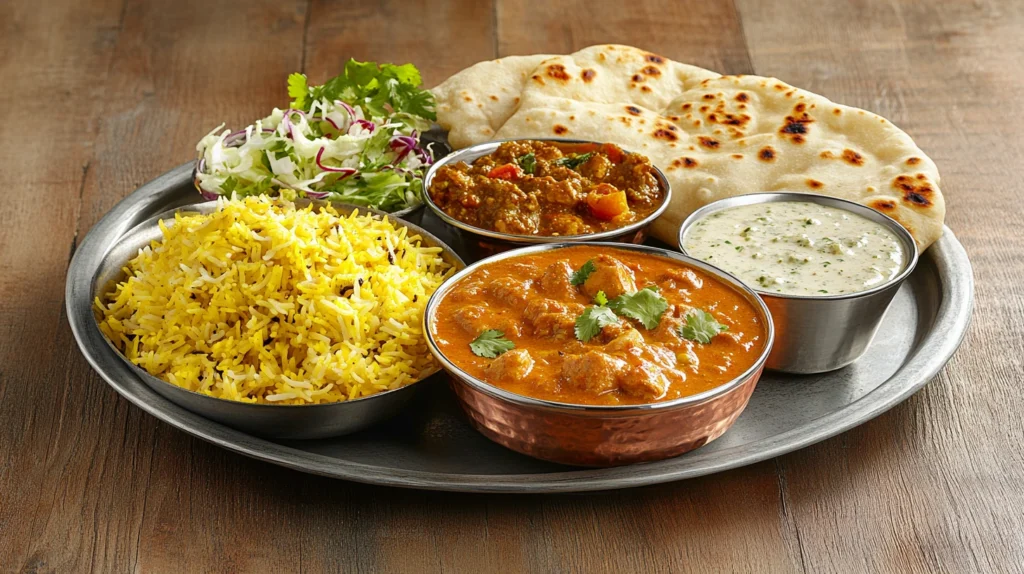
South Asian cuisine is a vibrant fusion of bold flavors and rich complexity. From creamy curries to fragrant rice dishes and lentil-based stews, the food is vibrant and satisfying. Spices such as cumin, coriander, turmeric, cardamom, cinnamon, and cloves are foundational, often toasted or bloomed in oil to release their full aroma and taste.
Classic Indian Butter Chicken
Butter chicken, also known as murgh makhani, is a creamy tomato-based curry that has become a global favorite. It’s rich, buttery, and mildly spiced, making it an ideal introduction to Indian cuisine for beginners.
How to Make Authentic Butter Chicken
- Marinate the Chicken: Use yogurt, lemon juice, garlic, ginger, turmeric, and garam masala to tenderize and flavor the chicken.
- Grill or Sear: Traditionally, the chicken is cooked in a tandoor, but pan-searing or oven-baking also works.
- Make the Sauce: Sauté onions, ginger, and garlic, then simmer with tomatoes, cream, butter, and more spices.
- Combine & Simmer: Add the cooked chicken to the sauce and let it all marry together.
Serve with naan (Indian flatbread) or basmati rice for a filling and luxurious meal. Finish with a sprinkle of fresh cilantro and a light swirl of cream. for that restaurant-style finish.
Pakistani Biryani – A Spiced Asian Dish Worth Mastering
Biryani is a layered rice and meat dish known for its fragrant aroma, vibrant colors, and deep flavors. Originating from Persian influences, Pakistani biryani is often spicier and richer, especially in cities like Karachi and Lahore.
Biryani-Making Essentials
- Rice: Long-grain basmati rice soaked and parboiled before layering.
- Meat: Often chicken, beef, or mutton marinated in yogurt, fried onions, and biryani masala.
- Spices: Cinnamon, cloves, cardamom, star anise, and saffron are key.
- Layering: Alternate layers of rice and meat in a heavy pot, seal with dough or a lid, and cook over low heat (“dum” method) to infuse flavors.
The final result is a beautiful mix of spicy, juicy meat and fluffy, saffron-infused rice. Serve with raita (a yogurt-based side dish), salad, and lemon wedges.
Sri Lankan Dhal Curry
Sri Lankan dhal curry is a comforting dish made with red lentils simmered in coconut milk, onions, and spices. It’s a staple in most Sri Lankan homes and often served as part of a larger rice and curry platter.
What Makes Sri Lankan Dhal Unique
- Lentils: Red split lentils (masoor dal) cook quickly and become creamy.
- Tempering: Mustard seeds, curry leaves, garlic, and dry red chilies are tempered in coconut oil and added to the curry at the end.
- Coconut Milk: Adds sweetness and richness that balances the spice.
This dish is naturally vegan, gluten-free, and incredibly nourishing. Serve it with steamed rice, roti, or string hoppers for a traditional experience.
From the buttery smoothness of Indian curries to the spiced layers of biryani and the coconut-infused simplicity of Sri Lankan dhal, South Asian cuisine offers a world of comforting meals that bring families together. These recipes reflect the hospitality, depth, and heritage of a region that treats food as both art and connection.
Home Cooking Tips for Delicious and Authentic Asian Food Recipes
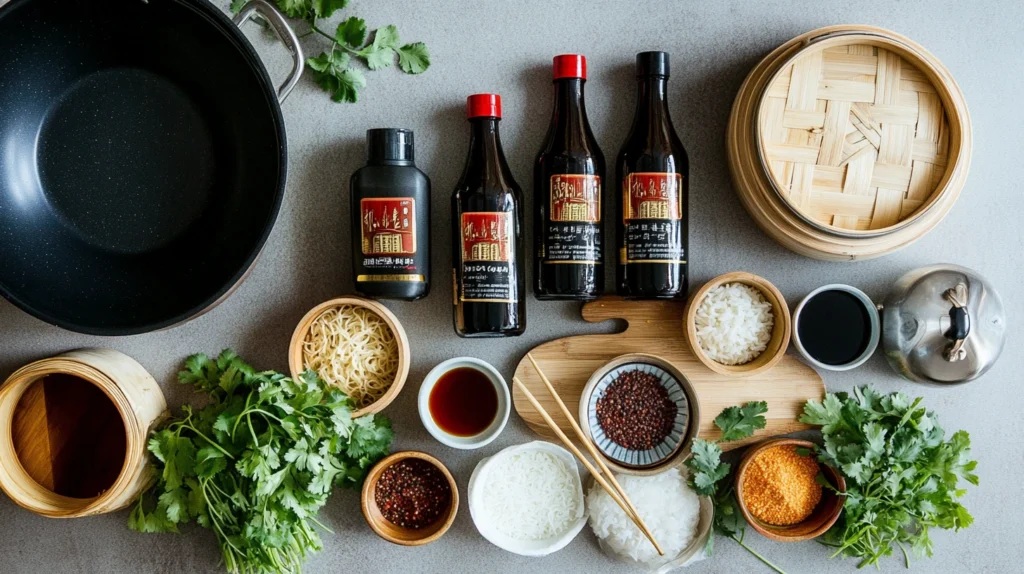
Cooking Asian food at home can be an exciting and fulfilling experience. Whether you’re preparing a simple stir-fry or a slow-simmered curry, a few smart tips and essential tools can make all the difference.
Essential Asian Pantry Staples
Before you start cooking, it’s helpful to stock your pantry with the fundamental ingredients found in most Asian cuisines. These staples add layers of flavor and allow you to prepare a wide range of recipes from different regions.
Must-Have Ingredients
- Soy Sauce: A universal flavor enhancer, available in light and dark varieties.
- Fish Sauce: Salty and umami-rich, used especially in Southeast Asian cooking.
- Oyster Sauce: Adds a deep, savory glaze to stir-fries and braised dishes.
- Rice Vinegar: Provides acidity in Japanese and Chinese dishes.
- Coconut Milk: Essential for Thai and Sri Lankan curries.
- Sesame Oil: Nutty and aromatic—best used as a finishing oil.
- Spices: Cumin, coriander, turmeric, cinnamon, star anise, and cloves.
- Herbs: Cilantro, Thai basil, mint, curry leaves.
- Noodles & Rice: Jasmine rice, basmati rice, rice noodles, udon, and ramen.
Tools You Need for Authentic Asian Cooking
Having the right tools can significantly elevate your cooking game. These kitchen items make traditional techniques easier and help deliver authentic textures and flavors.
Recommended Tools
- Wok: Versatile for stir-frying, deep frying, and steaming.
- Rice Cooker: Ensures perfectly cooked rice every time—fluffy, not sticky.
- Bamboo Steamer: Ideal for dumplings, buns, and vegetables.
- Mortar and Pestle: Used for grinding spices and pastes, especially in Thai cooking.
- Cleaver or Santoku Knife: For precision chopping and slicing.
- Ladle & Spider Strainer: Useful for soups, frying, and boiling.
Common Mistakes When Making Asian Recipes
Even with the best intentions, some common errors can prevent your dish from reaching its full potential. Avoiding these pitfalls can take your homemade Asian recipes from average to amazing.
Overcooking or Undercooking Rice and Noodles
Getting the texture right is critical. Overcooked rice becomes mushy, while undercooked noodles can be too chewy. Always follow package directions and test for doneness. Soaking rice or rinsing noodles can also affect texture, so don’t skip these steps when the recipe calls for them.
Using the Wrong Type of Soy Sauce
Not all soy sauces are created equal. Light soy sauce is saltier and better for marinades and stir-fries. Dark soy sauce has a thicker, sweeter profile and is often used to add depth and rich color to dishes. Using one in place of the other can dramatically change the taste of your dish.
Skipping the Aromatics
Garlic, ginger, scallions, lemongrass, and shallots commonly form the flavorful foundation of many Asian dishes. Skipping or substituting these aromatics can flatten the flavor. Always start by sautéing or toasting these ingredients to build depth from the beginning.
Overcrowding the Pan
Especially in stir-frying, putting too much in the pan at once lowers the heat and causes steaming instead of searing. Cook in batches if needed to maintain high heat and achieve the signature crisp texture.
Not Tasting and Adjusting
Balance is essential in Asian cooking. A bit of soy sauce, a hint of sugar, or a splash of vinegar can completely elevate the flavors of a dish. Always taste as you go and adjust for saltiness, sweetness, acidity, and spice to suit your palate.
Cooking Asian food at home can be easy, rewarding, and incredibly delicious—as long as you’re mindful of the small details that make a big difference. With the right ingredients, tools, and techniques, you’ll be well on your way to mastering these timeless dishes.
Frequently Asked Questions
What is the most popular Asian dish?
The title of “most popular Asian dish” is hotly contested, but sushi from Japan and Chinese fried rice often top the list worldwide. Sushi is celebrated for its elegance, simplicity, and variety, while fried rice is universally loved for its flavor and flexibility. Other contenders include pad Thai, pho, and butter chicken, which have become beloved staples in both restaurants and home kitchens across the globe. Popularity varies by region, but these dishes continue to represent the diversity and accessibility of Asian cuisine.
What Asian food is easy to make?
Many Asian recipes are surprisingly easy to make, even for beginners. Some of the simplest dishes include:
- Vegetable Stir-Fry: Quick, nutritious, and endlessly customizable.
- Miso Soup: Only requires miso paste, tofu, seaweed, and scallions.
- Fried Rice: A great way to use up leftovers and ready in minutes.
- Chicken Teriyaki: Requires minimal ingredients and packs tons of flavor.
- Ramen with Toppings: Start with a rich, flavorful broth and finish with a soft-boiled egg, fresh vegetables, and your choice of protein.
These dishes use pantry staples and don’t require advanced cooking skills, making them perfect for weeknight meals or quick lunches.
What are Asian basic foods?
Across Asia, several foods serve as the foundation for countless meals. The most common basic foods in Asian cuisine include:
- Rice: The ultimate staple, whether jasmine, basmati, sticky, or brown.
- Noodles: Rice noodles, soba, udon, and egg noodles are widely used.
- Soy Products: Staples like soy sauce, tofu, and miso are key components in many Asian dishes.
- Vegetables: Bok choy, cabbage, carrots, bean sprouts, and mushrooms.
- Spices and Sauces: Ginger, garlic, fish sauce, oyster sauce, curry pastes. These ingredients form the base of stir-fries, soups, salads, and curries throughout the continent.
What to bring for potluck Asian?
Asian dishes are perfect for potlucks because they’re flavorful, travel well, and often feed a crowd. Great options include:
- Spring Rolls: Fresh or fried, always a hit with dipping sauces.
- Chicken Satay: Skewered meat with a side of peanut sauce.
- Fried Rice or Noodles: Easy to serve and universally liked.
- Asian Slaw: Crunchy, colorful, and refreshing with sesame dressing.
- Dumplings: Can be made ahead and reheated or steamed on-site.
Try to bring something that doesn’t require reheating or complicated plating for ease and convenience.
What are popular Asian appetizers?
Asian cuisine offers a diverse array of appetizers that awaken the palate and highlight bold, vibrant flavors.Some popular options include:
- Gyoza (Japanese dumplings)
- Vietnamese Fresh Spring Rolls (Gỏi cuốn)
- Korean Pancakes (Pajeon)
- Crab Rangoon (American-Chinese fusion)
- Thai Chicken Satay
- Chinese Scallion Pancakes
- Edamame with Sea Salt
These appetizers are often bite-sized, easy to share, and packed with flavor, making them a great start to any meal.
What to bring for Asian parents?
Bringing food for Asian parents—especially when visiting someone’s home—can be a respectful and appreciated gesture. Here are some thoughtful ideas:
- Traditional Desserts: Such as mochi, mango sticky rice, or mooncakes.
- Home-Cooked Meals: A neatly packed dish like stir-fry, curry, or dumplings shows effort and care.
- Fresh Fruits: Asian households often appreciate seasonal or tropical fruits.
- Tea Gift Sets: Jasmine, oolong, or green tea are classy and culturally appropriate.
- Non-food Gifts: If unsure, a beautiful box of snacks or even a fruit basket will go a long way.
Always aim for something thoughtful and neatly presented—it’s the gesture that counts most.
Conclusion
Asian food recipes offer more than just meals—they’re cultural experiences, shared stories, and age-old traditions passed down through generations. From the fiery curries of South Asia to the clean simplicity of Japanese sushi, each dish tells its own story through ingredients, textures, and flavors.
Cooking Asian food at home doesn’t have to be complicated. With the right pantry staples, essential tools, and a willingness to explore, anyone can recreate these dishes in their own kitchen. Whether you start with a basic stir-fry, try your hand at sushi rolling, or simmer a rich butter chicken, each step is a flavorful journey worth taking.
Remember, Asian cuisine is about balance—not just in taste, but also in presentation, texture, and nutrition. These recipes give you a chance to experience that harmony in every bite. So go ahead—shop for those sauces, dust off that wok, and dive into the colorful, aromatic, and soul-warming world of Asian food recipes.🍜🥟🍛🥢
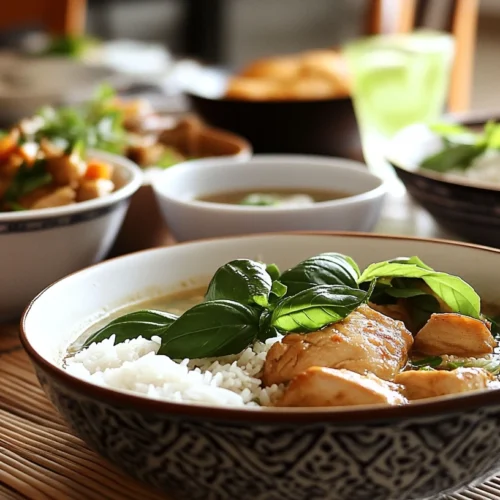
Asian Food Recipes – Easy, Flavorful & Authentic Dishes from Across Asia
Equipment
- Wok or large skillet
- Rice cooker or pot with lid
- Chef’s knife
- Cutting board
- Bamboo steamer (optional)
- Mixing bowls
- Wooden spoon or spatula
- Mortar and pestle (optional, for spice pastes)
Ingredients
- For Chicken Stir-Fry:
- 2 chicken breasts thinly sliced
- 2 tablespoons soy sauce
- 1 tablespoon oyster sauce
- 1 teaspoon sesame oil
- 2 garlic cloves minced
- 1- inch ginger minced
- 1 bell pepper sliced
- 1 cup broccoli florets
- 2 tablespoons vegetable oil
- 1 teaspoon cornstarch optional
- For Jasmine Rice:
- 1 cup jasmine rice
- 1½ cups water
- Pinch of salt
- For Thai Green Curry Vegetarian:
- 1 tablespoon green curry paste
- 1 can 400ml coconut milk
- 1 cup mixed vegetables zucchini, eggplant, bell pepper
- 1 teaspoon soy sauce
- 1 tablespoon fish sauce or vegetarian substitute
- 1 handful Thai basil
- 1 tablespoon oil
Instructions
- Chicken Stir-Fry:
- In a bowl, marinate chicken with soy sauce, oyster sauce, and sesame oil for 15 minutes.
- Heat oil in a wok over high heat. Add garlic and ginger, stir until fragrant.
- Add chicken and stir-fry until browned.
- Add vegetables and cook for 3–4 minutes.
- Mix cornstarch with 2 tbsp water and add if a thicker sauce is desired.
- Serve hot with jasmine rice.
- Jasmine Rice:
- Rinse rice under cold water until water runs clear.
- Combine rice, water, and salt in a pot or rice cooker.
- Cook on low heat for 15–18 minutes or use rice cooker settings. Let sit 5 minutes before fluffing.
- Thai Green Curry:
- Heat oil in a pan. Add green curry paste and stir for 1 minute.
- Pour in coconut milk and bring to a simmer.
- Add vegetables, soy sauce, and fish sauce. Cook until vegetables are tender.
- Stir in Thai basil before serving.

